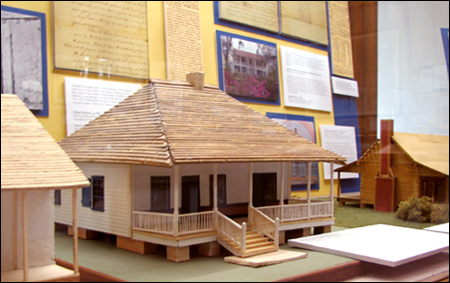Special Collections tells statehood story in new exhibition
In honor of the bicentennial of Louisiana’s admission to the Union as the 18th state, the LSU Libraries Special Collections presents “State of Transition: Louisiana Circa 1812,” a new exhibition on display from March 12 through June 2, 2012, at LSU's Hill Memorial Library.
The exhibit details topics of daily life during Louisiana’s transformation from territory to state in the early 19th century and answers such questions as--What did people eat and wear? How did they make a living? What did they do for fun?
In addition to these topics, the exhibit examines the at times rancorous political process through which Louisiana attained statehood, established its government and became “American”; the War of 1812 and the unique role Louisiana played in the conflict, and institutions such as slavery and religion that made up the fabric of Louisianans' daily experiences.
Prominent statesmen like William C.C. Claiborne and Julien Poydras are profiled, as are “everyday” residents found in the historical record. All contemporary inhabitants are represented in some way, reflecting the diverse ethnic, linguistic, religious, and socio-economic landscape of Louisiana in the era of early statehood.
The display draws mainly from the extensive print and manuscript holdings housed in the Louisiana and Lower Mississippi Valley Collections of the LSU Libraries Special Collections. Notable items shown include selections from Governor William Claiborne’s correspondence, the state’s first constitution, original newspapers of the period (as well as a multi-page facsimile for exhibit-goers to peruse), important early maps, accounts of New Orleans recreation and entertainment, a retrospective on the legend of Jean Lafitte, a letter from Andrew Jackson to his wife while en route to the Battle of New Orleans, material related to early steamboat travel, and documents about the 1811 slave revolt.
The exhibition also features models of homes typical of the era, on loan from the LSU Department of Geography and Anthropology’s Fred Kniffen Lab, in addition to artifacts from the LSU Textile and Costume Museum. Watercolors of the Baton Rouge riverfront are featured, courtesy of the Friends of Magnolia Mound.
The exhibition is free and open to the public.
Hill Memorial Library is open from 9 a.m. to 5 p.m., Monday through Friday, and 9 a.m. to 1 p.m. on Saturdays. When classes are in session, the library is open Tuesday evenings until 8 p.m. Paid parking is available at the Visitors’ Center, Memorial Tower, and Mike the Tiger’s Habitat. For more information, visit the Special Collections’ Web site at www.lib.lsu.edu/special.

